Strategic Leadership and Management in the 21st Century: An Overview
VerifiedAdded on 2023/05/31
|7
|2937
|221
Report
AI Summary
This report delves into the evolution of leadership and strategic management in the dynamic landscape of the 21st century. It begins by contrasting traditional hierarchical models with the need for decentralized controls, given the volatile and complex business environment. The report emphasizes the importance of effective leadership approaches and strategic management for organizational survival and growth. It explores leadership approaches, including strategic and functional leadership, highlighting the significance of guiding, communicating organizational goals, and fostering employee engagement. The report further examines strategic development, encompassing strategic planning, management, and execution, with an emphasis on adapting to an uncertain environment. It underscores the need for organizations to adopt scenario-based strategic planning to navigate future challenges and achieve long-term success.

Strategic Marketing 1
Strategic Marketing
Strategic Marketing
Paraphrase This Document
Need a fresh take? Get an instant paraphrase of this document with our AI Paraphraser
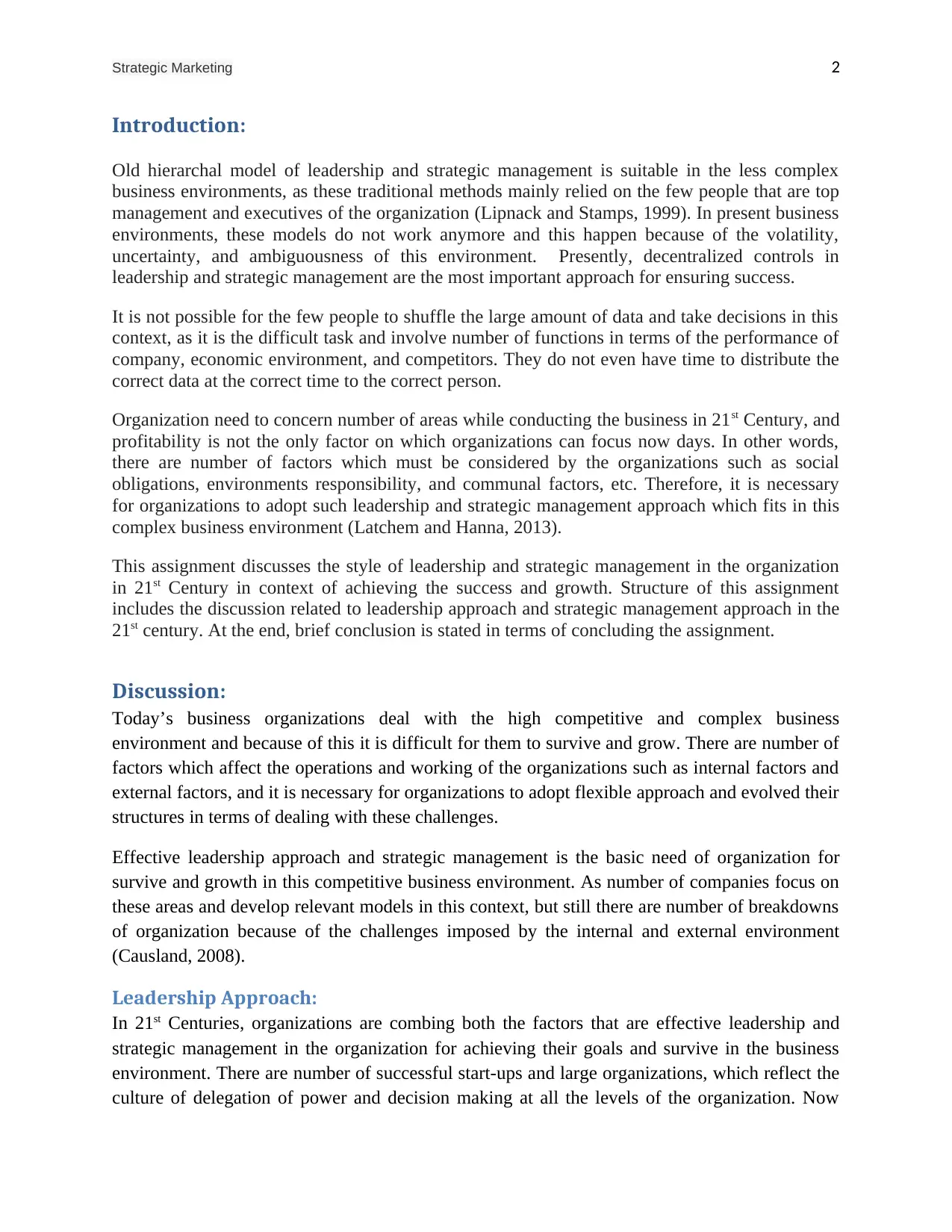
Strategic Marketing 2
Introduction:
Old hierarchal model of leadership and strategic management is suitable in the less complex
business environments, as these traditional methods mainly relied on the few people that are top
management and executives of the organization (Lipnack and Stamps, 1999). In present business
environments, these models do not work anymore and this happen because of the volatility,
uncertainty, and ambiguousness of this environment. Presently, decentralized controls in
leadership and strategic management are the most important approach for ensuring success.
It is not possible for the few people to shuffle the large amount of data and take decisions in this
context, as it is the difficult task and involve number of functions in terms of the performance of
company, economic environment, and competitors. They do not even have time to distribute the
correct data at the correct time to the correct person.
Organization need to concern number of areas while conducting the business in 21st Century, and
profitability is not the only factor on which organizations can focus now days. In other words,
there are number of factors which must be considered by the organizations such as social
obligations, environments responsibility, and communal factors, etc. Therefore, it is necessary
for organizations to adopt such leadership and strategic management approach which fits in this
complex business environment (Latchem and Hanna, 2013).
This assignment discusses the style of leadership and strategic management in the organization
in 21st Century in context of achieving the success and growth. Structure of this assignment
includes the discussion related to leadership approach and strategic management approach in the
21st century. At the end, brief conclusion is stated in terms of concluding the assignment.
Discussion:
Today’s business organizations deal with the high competitive and complex business
environment and because of this it is difficult for them to survive and grow. There are number of
factors which affect the operations and working of the organizations such as internal factors and
external factors, and it is necessary for organizations to adopt flexible approach and evolved their
structures in terms of dealing with these challenges.
Effective leadership approach and strategic management is the basic need of organization for
survive and growth in this competitive business environment. As number of companies focus on
these areas and develop relevant models in this context, but still there are number of breakdowns
of organization because of the challenges imposed by the internal and external environment
(Causland, 2008).
Leadership Approach:
In 21st Centuries, organizations are combing both the factors that are effective leadership and
strategic management in the organization for achieving their goals and survive in the business
environment. There are number of successful start-ups and large organizations, which reflect the
culture of delegation of power and decision making at all the levels of the organization. Now
Introduction:
Old hierarchal model of leadership and strategic management is suitable in the less complex
business environments, as these traditional methods mainly relied on the few people that are top
management and executives of the organization (Lipnack and Stamps, 1999). In present business
environments, these models do not work anymore and this happen because of the volatility,
uncertainty, and ambiguousness of this environment. Presently, decentralized controls in
leadership and strategic management are the most important approach for ensuring success.
It is not possible for the few people to shuffle the large amount of data and take decisions in this
context, as it is the difficult task and involve number of functions in terms of the performance of
company, economic environment, and competitors. They do not even have time to distribute the
correct data at the correct time to the correct person.
Organization need to concern number of areas while conducting the business in 21st Century, and
profitability is not the only factor on which organizations can focus now days. In other words,
there are number of factors which must be considered by the organizations such as social
obligations, environments responsibility, and communal factors, etc. Therefore, it is necessary
for organizations to adopt such leadership and strategic management approach which fits in this
complex business environment (Latchem and Hanna, 2013).
This assignment discusses the style of leadership and strategic management in the organization
in 21st Century in context of achieving the success and growth. Structure of this assignment
includes the discussion related to leadership approach and strategic management approach in the
21st century. At the end, brief conclusion is stated in terms of concluding the assignment.
Discussion:
Today’s business organizations deal with the high competitive and complex business
environment and because of this it is difficult for them to survive and grow. There are number of
factors which affect the operations and working of the organizations such as internal factors and
external factors, and it is necessary for organizations to adopt flexible approach and evolved their
structures in terms of dealing with these challenges.
Effective leadership approach and strategic management is the basic need of organization for
survive and growth in this competitive business environment. As number of companies focus on
these areas and develop relevant models in this context, but still there are number of breakdowns
of organization because of the challenges imposed by the internal and external environment
(Causland, 2008).
Leadership Approach:
In 21st Centuries, organizations are combing both the factors that are effective leadership and
strategic management in the organization for achieving their goals and survive in the business
environment. There are number of successful start-ups and large organizations, which reflect the
culture of delegation of power and decision making at all the levels of the organization. Now
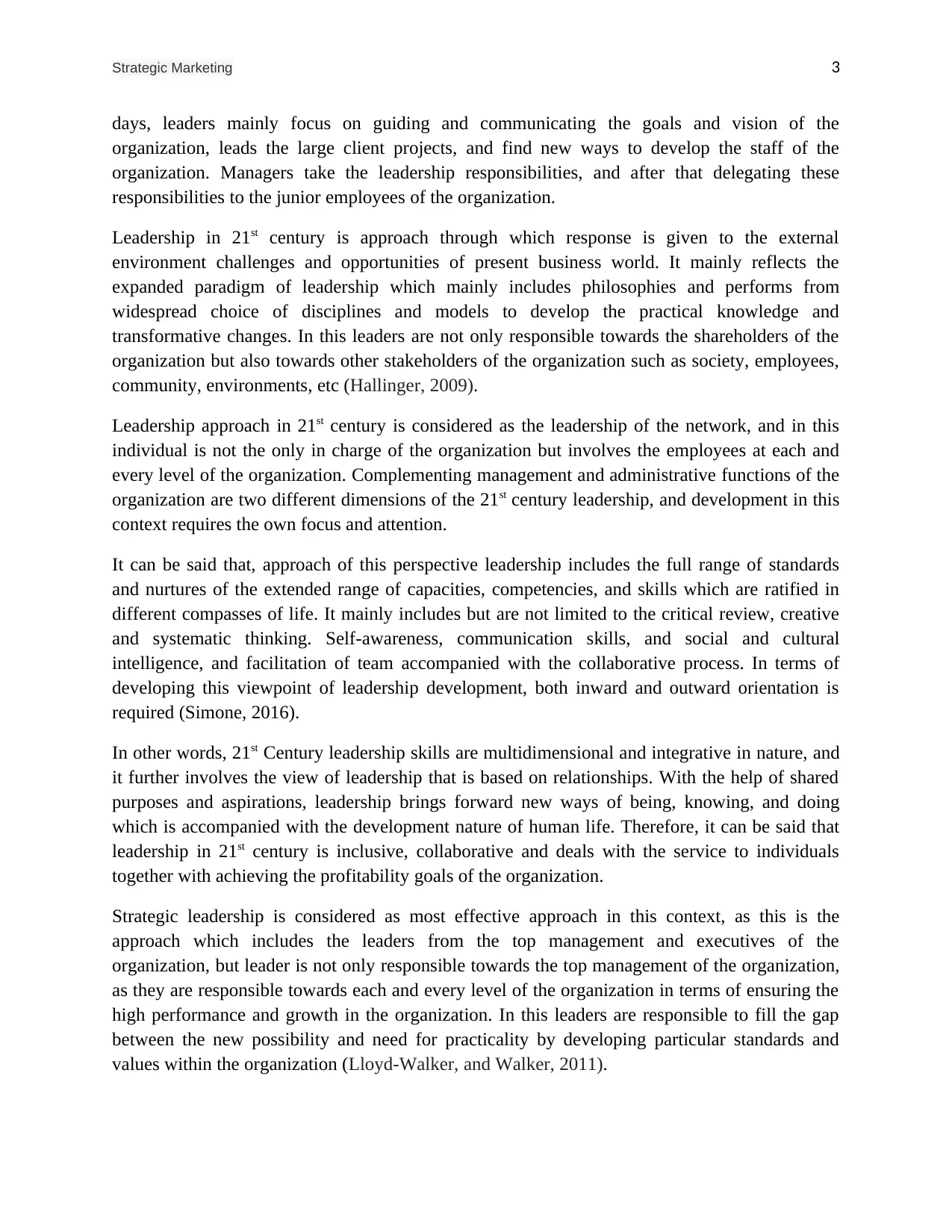
Strategic Marketing 3
days, leaders mainly focus on guiding and communicating the goals and vision of the
organization, leads the large client projects, and find new ways to develop the staff of the
organization. Managers take the leadership responsibilities, and after that delegating these
responsibilities to the junior employees of the organization.
Leadership in 21st century is approach through which response is given to the external
environment challenges and opportunities of present business world. It mainly reflects the
expanded paradigm of leadership which mainly includes philosophies and performs from
widespread choice of disciplines and models to develop the practical knowledge and
transformative changes. In this leaders are not only responsible towards the shareholders of the
organization but also towards other stakeholders of the organization such as society, employees,
community, environments, etc (Hallinger, 2009).
Leadership approach in 21st century is considered as the leadership of the network, and in this
individual is not the only in charge of the organization but involves the employees at each and
every level of the organization. Complementing management and administrative functions of the
organization are two different dimensions of the 21st century leadership, and development in this
context requires the own focus and attention.
It can be said that, approach of this perspective leadership includes the full range of standards
and nurtures of the extended range of capacities, competencies, and skills which are ratified in
different compasses of life. It mainly includes but are not limited to the critical review, creative
and systematic thinking. Self-awareness, communication skills, and social and cultural
intelligence, and facilitation of team accompanied with the collaborative process. In terms of
developing this viewpoint of leadership development, both inward and outward orientation is
required (Simone, 2016).
In other words, 21st Century leadership skills are multidimensional and integrative in nature, and
it further involves the view of leadership that is based on relationships. With the help of shared
purposes and aspirations, leadership brings forward new ways of being, knowing, and doing
which is accompanied with the development nature of human life. Therefore, it can be said that
leadership in 21st century is inclusive, collaborative and deals with the service to individuals
together with achieving the profitability goals of the organization.
Strategic leadership is considered as most effective approach in this context, as this is the
approach which includes the leaders from the top management and executives of the
organization, but leader is not only responsible towards the top management of the organization,
as they are responsible towards each and every level of the organization in terms of ensuring the
high performance and growth in the organization. In this leaders are responsible to fill the gap
between the new possibility and need for practicality by developing particular standards and
values within the organization (Lloyd-Walker, and Walker, 2011).
days, leaders mainly focus on guiding and communicating the goals and vision of the
organization, leads the large client projects, and find new ways to develop the staff of the
organization. Managers take the leadership responsibilities, and after that delegating these
responsibilities to the junior employees of the organization.
Leadership in 21st century is approach through which response is given to the external
environment challenges and opportunities of present business world. It mainly reflects the
expanded paradigm of leadership which mainly includes philosophies and performs from
widespread choice of disciplines and models to develop the practical knowledge and
transformative changes. In this leaders are not only responsible towards the shareholders of the
organization but also towards other stakeholders of the organization such as society, employees,
community, environments, etc (Hallinger, 2009).
Leadership approach in 21st century is considered as the leadership of the network, and in this
individual is not the only in charge of the organization but involves the employees at each and
every level of the organization. Complementing management and administrative functions of the
organization are two different dimensions of the 21st century leadership, and development in this
context requires the own focus and attention.
It can be said that, approach of this perspective leadership includes the full range of standards
and nurtures of the extended range of capacities, competencies, and skills which are ratified in
different compasses of life. It mainly includes but are not limited to the critical review, creative
and systematic thinking. Self-awareness, communication skills, and social and cultural
intelligence, and facilitation of team accompanied with the collaborative process. In terms of
developing this viewpoint of leadership development, both inward and outward orientation is
required (Simone, 2016).
In other words, 21st Century leadership skills are multidimensional and integrative in nature, and
it further involves the view of leadership that is based on relationships. With the help of shared
purposes and aspirations, leadership brings forward new ways of being, knowing, and doing
which is accompanied with the development nature of human life. Therefore, it can be said that
leadership in 21st century is inclusive, collaborative and deals with the service to individuals
together with achieving the profitability goals of the organization.
Strategic leadership is considered as most effective approach in this context, as this is the
approach which includes the leaders from the top management and executives of the
organization, but leader is not only responsible towards the top management of the organization,
as they are responsible towards each and every level of the organization in terms of ensuring the
high performance and growth in the organization. In this leaders are responsible to fill the gap
between the new possibility and need for practicality by developing particular standards and
values within the organization (Lloyd-Walker, and Walker, 2011).
⊘ This is a preview!⊘
Do you want full access?
Subscribe today to unlock all pages.

Trusted by 1+ million students worldwide
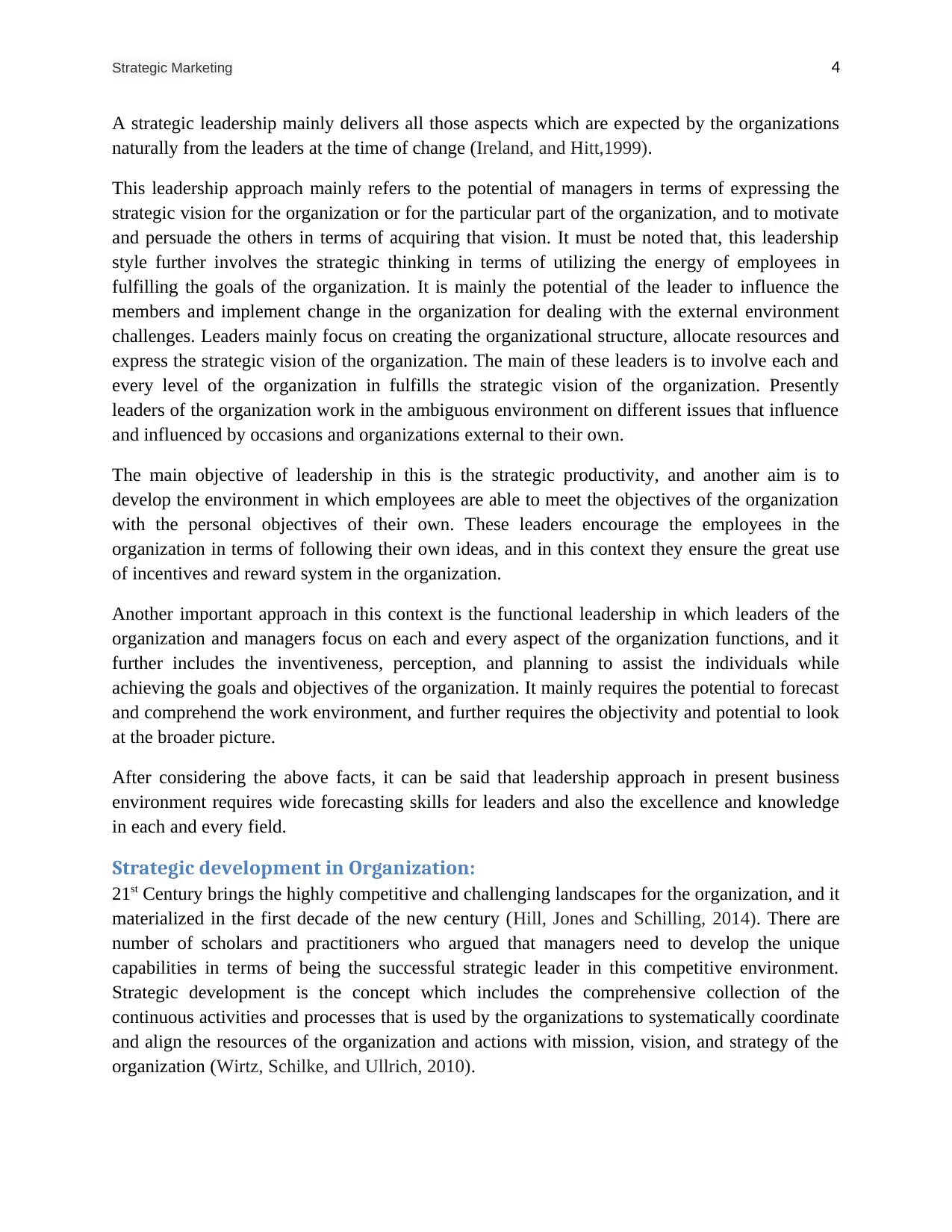
Strategic Marketing 4
A strategic leadership mainly delivers all those aspects which are expected by the organizations
naturally from the leaders at the time of change (Ireland, and Hitt,1999).
This leadership approach mainly refers to the potential of managers in terms of expressing the
strategic vision for the organization or for the particular part of the organization, and to motivate
and persuade the others in terms of acquiring that vision. It must be noted that, this leadership
style further involves the strategic thinking in terms of utilizing the energy of employees in
fulfilling the goals of the organization. It is mainly the potential of the leader to influence the
members and implement change in the organization for dealing with the external environment
challenges. Leaders mainly focus on creating the organizational structure, allocate resources and
express the strategic vision of the organization. The main of these leaders is to involve each and
every level of the organization in fulfills the strategic vision of the organization. Presently
leaders of the organization work in the ambiguous environment on different issues that influence
and influenced by occasions and organizations external to their own.
The main objective of leadership in this is the strategic productivity, and another aim is to
develop the environment in which employees are able to meet the objectives of the organization
with the personal objectives of their own. These leaders encourage the employees in the
organization in terms of following their own ideas, and in this context they ensure the great use
of incentives and reward system in the organization.
Another important approach in this context is the functional leadership in which leaders of the
organization and managers focus on each and every aspect of the organization functions, and it
further includes the inventiveness, perception, and planning to assist the individuals while
achieving the goals and objectives of the organization. It mainly requires the potential to forecast
and comprehend the work environment, and further requires the objectivity and potential to look
at the broader picture.
After considering the above facts, it can be said that leadership approach in present business
environment requires wide forecasting skills for leaders and also the excellence and knowledge
in each and every field.
Strategic development in Organization:
21st Century brings the highly competitive and challenging landscapes for the organization, and it
materialized in the first decade of the new century (Hill, Jones and Schilling, 2014). There are
number of scholars and practitioners who argued that managers need to develop the unique
capabilities in terms of being the successful strategic leader in this competitive environment.
Strategic development is the concept which includes the comprehensive collection of the
continuous activities and processes that is used by the organizations to systematically coordinate
and align the resources of the organization and actions with mission, vision, and strategy of the
organization (Wirtz, Schilke, and Ullrich, 2010).
A strategic leadership mainly delivers all those aspects which are expected by the organizations
naturally from the leaders at the time of change (Ireland, and Hitt,1999).
This leadership approach mainly refers to the potential of managers in terms of expressing the
strategic vision for the organization or for the particular part of the organization, and to motivate
and persuade the others in terms of acquiring that vision. It must be noted that, this leadership
style further involves the strategic thinking in terms of utilizing the energy of employees in
fulfilling the goals of the organization. It is mainly the potential of the leader to influence the
members and implement change in the organization for dealing with the external environment
challenges. Leaders mainly focus on creating the organizational structure, allocate resources and
express the strategic vision of the organization. The main of these leaders is to involve each and
every level of the organization in fulfills the strategic vision of the organization. Presently
leaders of the organization work in the ambiguous environment on different issues that influence
and influenced by occasions and organizations external to their own.
The main objective of leadership in this is the strategic productivity, and another aim is to
develop the environment in which employees are able to meet the objectives of the organization
with the personal objectives of their own. These leaders encourage the employees in the
organization in terms of following their own ideas, and in this context they ensure the great use
of incentives and reward system in the organization.
Another important approach in this context is the functional leadership in which leaders of the
organization and managers focus on each and every aspect of the organization functions, and it
further includes the inventiveness, perception, and planning to assist the individuals while
achieving the goals and objectives of the organization. It mainly requires the potential to forecast
and comprehend the work environment, and further requires the objectivity and potential to look
at the broader picture.
After considering the above facts, it can be said that leadership approach in present business
environment requires wide forecasting skills for leaders and also the excellence and knowledge
in each and every field.
Strategic development in Organization:
21st Century brings the highly competitive and challenging landscapes for the organization, and it
materialized in the first decade of the new century (Hill, Jones and Schilling, 2014). There are
number of scholars and practitioners who argued that managers need to develop the unique
capabilities in terms of being the successful strategic leader in this competitive environment.
Strategic development is the concept which includes the comprehensive collection of the
continuous activities and processes that is used by the organizations to systematically coordinate
and align the resources of the organization and actions with mission, vision, and strategy of the
organization (Wirtz, Schilke, and Ullrich, 2010).
Paraphrase This Document
Need a fresh take? Get an instant paraphrase of this document with our AI Paraphraser
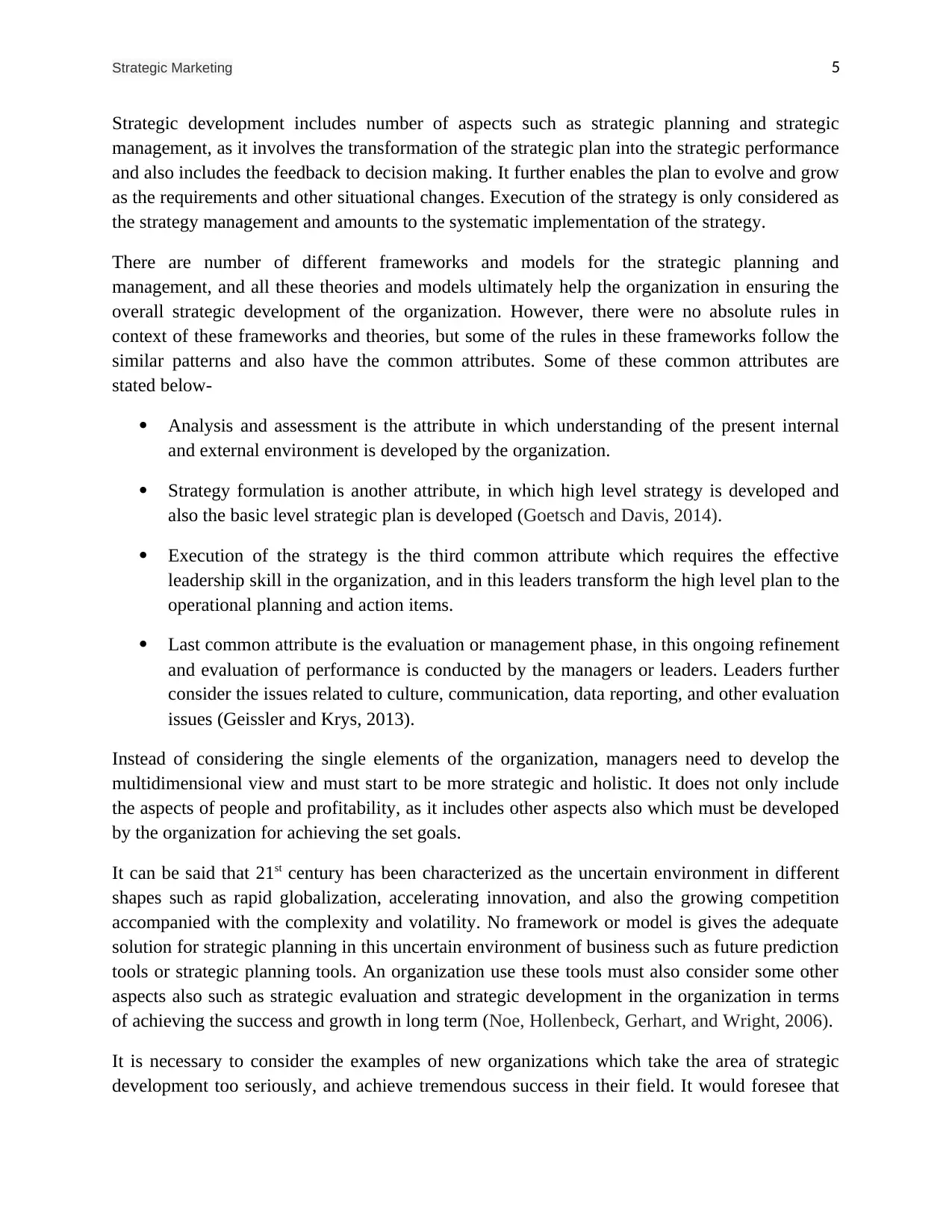
Strategic Marketing 5
Strategic development includes number of aspects such as strategic planning and strategic
management, as it involves the transformation of the strategic plan into the strategic performance
and also includes the feedback to decision making. It further enables the plan to evolve and grow
as the requirements and other situational changes. Execution of the strategy is only considered as
the strategy management and amounts to the systematic implementation of the strategy.
There are number of different frameworks and models for the strategic planning and
management, and all these theories and models ultimately help the organization in ensuring the
overall strategic development of the organization. However, there were no absolute rules in
context of these frameworks and theories, but some of the rules in these frameworks follow the
similar patterns and also have the common attributes. Some of these common attributes are
stated below-
Analysis and assessment is the attribute in which understanding of the present internal
and external environment is developed by the organization.
Strategy formulation is another attribute, in which high level strategy is developed and
also the basic level strategic plan is developed (Goetsch and Davis, 2014).
Execution of the strategy is the third common attribute which requires the effective
leadership skill in the organization, and in this leaders transform the high level plan to the
operational planning and action items.
Last common attribute is the evaluation or management phase, in this ongoing refinement
and evaluation of performance is conducted by the managers or leaders. Leaders further
consider the issues related to culture, communication, data reporting, and other evaluation
issues (Geissler and Krys, 2013).
Instead of considering the single elements of the organization, managers need to develop the
multidimensional view and must start to be more strategic and holistic. It does not only include
the aspects of people and profitability, as it includes other aspects also which must be developed
by the organization for achieving the set goals.
It can be said that 21st century has been characterized as the uncertain environment in different
shapes such as rapid globalization, accelerating innovation, and also the growing competition
accompanied with the complexity and volatility. No framework or model is gives the adequate
solution for strategic planning in this uncertain environment of business such as future prediction
tools or strategic planning tools. An organization use these tools must also consider some other
aspects also such as strategic evaluation and strategic development in the organization in terms
of achieving the success and growth in long term (Noe, Hollenbeck, Gerhart, and Wright, 2006).
It is necessary to consider the examples of new organizations which take the area of strategic
development too seriously, and achieve tremendous success in their field. It would foresee that
Strategic development includes number of aspects such as strategic planning and strategic
management, as it involves the transformation of the strategic plan into the strategic performance
and also includes the feedback to decision making. It further enables the plan to evolve and grow
as the requirements and other situational changes. Execution of the strategy is only considered as
the strategy management and amounts to the systematic implementation of the strategy.
There are number of different frameworks and models for the strategic planning and
management, and all these theories and models ultimately help the organization in ensuring the
overall strategic development of the organization. However, there were no absolute rules in
context of these frameworks and theories, but some of the rules in these frameworks follow the
similar patterns and also have the common attributes. Some of these common attributes are
stated below-
Analysis and assessment is the attribute in which understanding of the present internal
and external environment is developed by the organization.
Strategy formulation is another attribute, in which high level strategy is developed and
also the basic level strategic plan is developed (Goetsch and Davis, 2014).
Execution of the strategy is the third common attribute which requires the effective
leadership skill in the organization, and in this leaders transform the high level plan to the
operational planning and action items.
Last common attribute is the evaluation or management phase, in this ongoing refinement
and evaluation of performance is conducted by the managers or leaders. Leaders further
consider the issues related to culture, communication, data reporting, and other evaluation
issues (Geissler and Krys, 2013).
Instead of considering the single elements of the organization, managers need to develop the
multidimensional view and must start to be more strategic and holistic. It does not only include
the aspects of people and profitability, as it includes other aspects also which must be developed
by the organization for achieving the set goals.
It can be said that 21st century has been characterized as the uncertain environment in different
shapes such as rapid globalization, accelerating innovation, and also the growing competition
accompanied with the complexity and volatility. No framework or model is gives the adequate
solution for strategic planning in this uncertain environment of business such as future prediction
tools or strategic planning tools. An organization use these tools must also consider some other
aspects also such as strategic evaluation and strategic development in the organization in terms
of achieving the success and growth in long term (Noe, Hollenbeck, Gerhart, and Wright, 2006).
It is necessary to consider the examples of new organizations which take the area of strategic
development too seriously, and achieve tremendous success in their field. It would foresee that
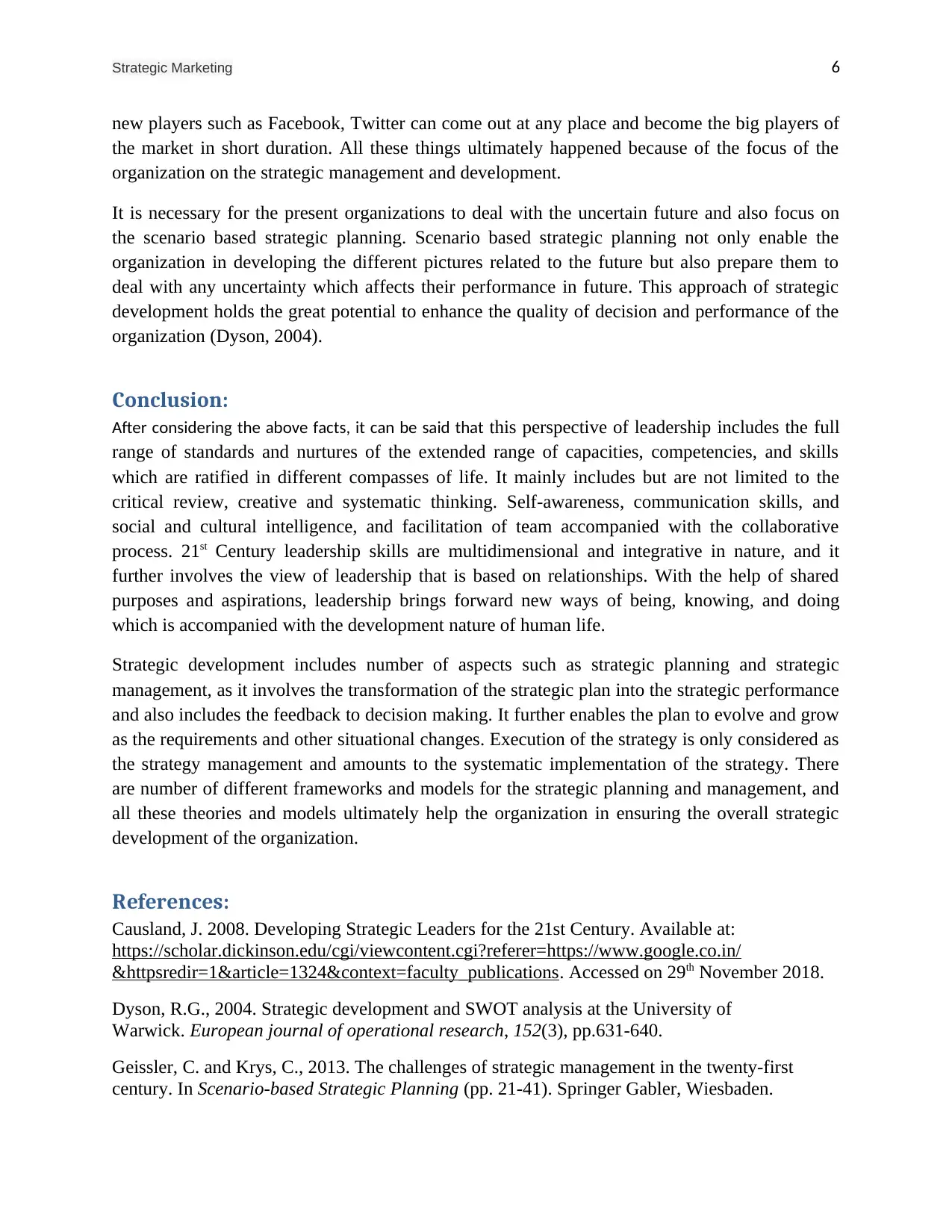
Strategic Marketing 6
new players such as Facebook, Twitter can come out at any place and become the big players of
the market in short duration. All these things ultimately happened because of the focus of the
organization on the strategic management and development.
It is necessary for the present organizations to deal with the uncertain future and also focus on
the scenario based strategic planning. Scenario based strategic planning not only enable the
organization in developing the different pictures related to the future but also prepare them to
deal with any uncertainty which affects their performance in future. This approach of strategic
development holds the great potential to enhance the quality of decision and performance of the
organization (Dyson, 2004).
Conclusion:
After considering the above facts, it can be said that this perspective of leadership includes the full
range of standards and nurtures of the extended range of capacities, competencies, and skills
which are ratified in different compasses of life. It mainly includes but are not limited to the
critical review, creative and systematic thinking. Self-awareness, communication skills, and
social and cultural intelligence, and facilitation of team accompanied with the collaborative
process. 21st Century leadership skills are multidimensional and integrative in nature, and it
further involves the view of leadership that is based on relationships. With the help of shared
purposes and aspirations, leadership brings forward new ways of being, knowing, and doing
which is accompanied with the development nature of human life.
Strategic development includes number of aspects such as strategic planning and strategic
management, as it involves the transformation of the strategic plan into the strategic performance
and also includes the feedback to decision making. It further enables the plan to evolve and grow
as the requirements and other situational changes. Execution of the strategy is only considered as
the strategy management and amounts to the systematic implementation of the strategy. There
are number of different frameworks and models for the strategic planning and management, and
all these theories and models ultimately help the organization in ensuring the overall strategic
development of the organization.
References:
Causland, J. 2008. Developing Strategic Leaders for the 21st Century. Available at:
https://scholar.dickinson.edu/cgi/viewcontent.cgi?referer=https://www.google.co.in/
&httpsredir=1&article=1324&context=faculty_publications. Accessed on 29th November 2018.
Dyson, R.G., 2004. Strategic development and SWOT analysis at the University of
Warwick. European journal of operational research, 152(3), pp.631-640.
Geissler, C. and Krys, C., 2013. The challenges of strategic management in the twenty-first
century. In Scenario-based Strategic Planning (pp. 21-41). Springer Gabler, Wiesbaden.
new players such as Facebook, Twitter can come out at any place and become the big players of
the market in short duration. All these things ultimately happened because of the focus of the
organization on the strategic management and development.
It is necessary for the present organizations to deal with the uncertain future and also focus on
the scenario based strategic planning. Scenario based strategic planning not only enable the
organization in developing the different pictures related to the future but also prepare them to
deal with any uncertainty which affects their performance in future. This approach of strategic
development holds the great potential to enhance the quality of decision and performance of the
organization (Dyson, 2004).
Conclusion:
After considering the above facts, it can be said that this perspective of leadership includes the full
range of standards and nurtures of the extended range of capacities, competencies, and skills
which are ratified in different compasses of life. It mainly includes but are not limited to the
critical review, creative and systematic thinking. Self-awareness, communication skills, and
social and cultural intelligence, and facilitation of team accompanied with the collaborative
process. 21st Century leadership skills are multidimensional and integrative in nature, and it
further involves the view of leadership that is based on relationships. With the help of shared
purposes and aspirations, leadership brings forward new ways of being, knowing, and doing
which is accompanied with the development nature of human life.
Strategic development includes number of aspects such as strategic planning and strategic
management, as it involves the transformation of the strategic plan into the strategic performance
and also includes the feedback to decision making. It further enables the plan to evolve and grow
as the requirements and other situational changes. Execution of the strategy is only considered as
the strategy management and amounts to the systematic implementation of the strategy. There
are number of different frameworks and models for the strategic planning and management, and
all these theories and models ultimately help the organization in ensuring the overall strategic
development of the organization.
References:
Causland, J. 2008. Developing Strategic Leaders for the 21st Century. Available at:
https://scholar.dickinson.edu/cgi/viewcontent.cgi?referer=https://www.google.co.in/
&httpsredir=1&article=1324&context=faculty_publications. Accessed on 29th November 2018.
Dyson, R.G., 2004. Strategic development and SWOT analysis at the University of
Warwick. European journal of operational research, 152(3), pp.631-640.
Geissler, C. and Krys, C., 2013. The challenges of strategic management in the twenty-first
century. In Scenario-based Strategic Planning (pp. 21-41). Springer Gabler, Wiesbaden.
⊘ This is a preview!⊘
Do you want full access?
Subscribe today to unlock all pages.

Trusted by 1+ million students worldwide
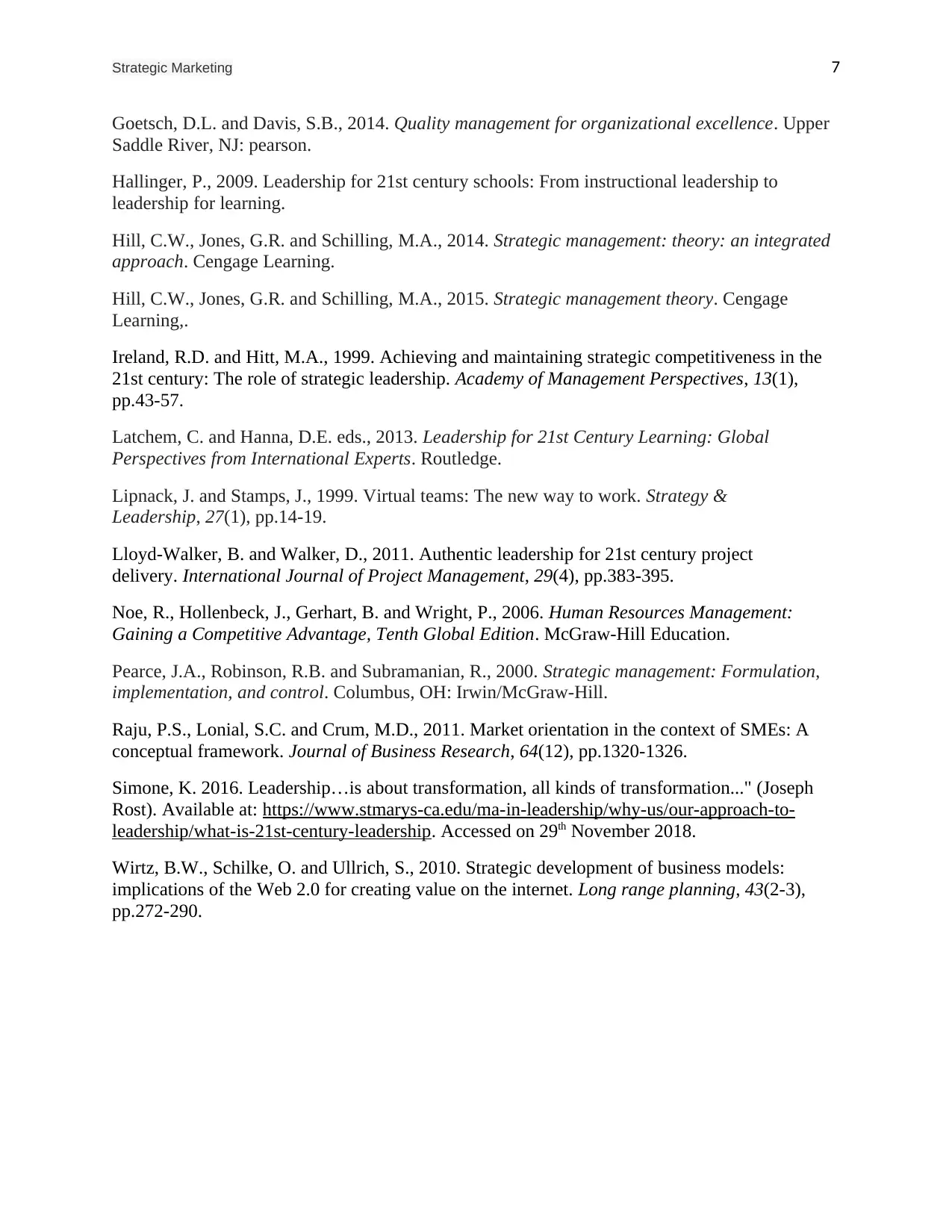
Strategic Marketing 7
Goetsch, D.L. and Davis, S.B., 2014. Quality management for organizational excellence. Upper
Saddle River, NJ: pearson.
Hallinger, P., 2009. Leadership for 21st century schools: From instructional leadership to
leadership for learning.
Hill, C.W., Jones, G.R. and Schilling, M.A., 2014. Strategic management: theory: an integrated
approach. Cengage Learning.
Hill, C.W., Jones, G.R. and Schilling, M.A., 2015. Strategic management theory. Cengage
Learning,.
Ireland, R.D. and Hitt, M.A., 1999. Achieving and maintaining strategic competitiveness in the
21st century: The role of strategic leadership. Academy of Management Perspectives, 13(1),
pp.43-57.
Latchem, C. and Hanna, D.E. eds., 2013. Leadership for 21st Century Learning: Global
Perspectives from International Experts. Routledge.
Lipnack, J. and Stamps, J., 1999. Virtual teams: The new way to work. Strategy &
Leadership, 27(1), pp.14-19.
Lloyd-Walker, B. and Walker, D., 2011. Authentic leadership for 21st century project
delivery. International Journal of Project Management, 29(4), pp.383-395.
Noe, R., Hollenbeck, J., Gerhart, B. and Wright, P., 2006. Human Resources Management:
Gaining a Competitive Advantage, Tenth Global Edition. McGraw-Hill Education.
Pearce, J.A., Robinson, R.B. and Subramanian, R., 2000. Strategic management: Formulation,
implementation, and control. Columbus, OH: Irwin/McGraw-Hill.
Raju, P.S., Lonial, S.C. and Crum, M.D., 2011. Market orientation in the context of SMEs: A
conceptual framework. Journal of Business Research, 64(12), pp.1320-1326.
Simone, K. 2016. Leadership…is about transformation, all kinds of transformation..." (Joseph
Rost). Available at: https://www.stmarys-ca.edu/ma-in-leadership/why-us/our-approach-to-
leadership/what-is-21st-century-leadership. Accessed on 29th November 2018.
Wirtz, B.W., Schilke, O. and Ullrich, S., 2010. Strategic development of business models:
implications of the Web 2.0 for creating value on the internet. Long range planning, 43(2-3),
pp.272-290.
Goetsch, D.L. and Davis, S.B., 2014. Quality management for organizational excellence. Upper
Saddle River, NJ: pearson.
Hallinger, P., 2009. Leadership for 21st century schools: From instructional leadership to
leadership for learning.
Hill, C.W., Jones, G.R. and Schilling, M.A., 2014. Strategic management: theory: an integrated
approach. Cengage Learning.
Hill, C.W., Jones, G.R. and Schilling, M.A., 2015. Strategic management theory. Cengage
Learning,.
Ireland, R.D. and Hitt, M.A., 1999. Achieving and maintaining strategic competitiveness in the
21st century: The role of strategic leadership. Academy of Management Perspectives, 13(1),
pp.43-57.
Latchem, C. and Hanna, D.E. eds., 2013. Leadership for 21st Century Learning: Global
Perspectives from International Experts. Routledge.
Lipnack, J. and Stamps, J., 1999. Virtual teams: The new way to work. Strategy &
Leadership, 27(1), pp.14-19.
Lloyd-Walker, B. and Walker, D., 2011. Authentic leadership for 21st century project
delivery. International Journal of Project Management, 29(4), pp.383-395.
Noe, R., Hollenbeck, J., Gerhart, B. and Wright, P., 2006. Human Resources Management:
Gaining a Competitive Advantage, Tenth Global Edition. McGraw-Hill Education.
Pearce, J.A., Robinson, R.B. and Subramanian, R., 2000. Strategic management: Formulation,
implementation, and control. Columbus, OH: Irwin/McGraw-Hill.
Raju, P.S., Lonial, S.C. and Crum, M.D., 2011. Market orientation in the context of SMEs: A
conceptual framework. Journal of Business Research, 64(12), pp.1320-1326.
Simone, K. 2016. Leadership…is about transformation, all kinds of transformation..." (Joseph
Rost). Available at: https://www.stmarys-ca.edu/ma-in-leadership/why-us/our-approach-to-
leadership/what-is-21st-century-leadership. Accessed on 29th November 2018.
Wirtz, B.W., Schilke, O. and Ullrich, S., 2010. Strategic development of business models:
implications of the Web 2.0 for creating value on the internet. Long range planning, 43(2-3),
pp.272-290.
1 out of 7
Related Documents
Your All-in-One AI-Powered Toolkit for Academic Success.
+13062052269
info@desklib.com
Available 24*7 on WhatsApp / Email
![[object Object]](/_next/static/media/star-bottom.7253800d.svg)
Unlock your academic potential
Copyright © 2020–2025 A2Z Services. All Rights Reserved. Developed and managed by ZUCOL.





